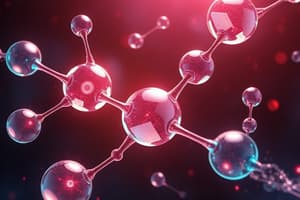Podcast
Questions and Answers
What does VSEPR theory help us determine in a molecule?
What does VSEPR theory help us determine in a molecule?
- Chemical bonding type
- Atomic number
- Electron domain geometry (correct)
- Atomic mass
Which type of forces are responsible for properties like boiling points and melting points?
Which type of forces are responsible for properties like boiling points and melting points?
- Dispersion forces (correct)
- Metallic bonds
- Ionic bonds
- Covalent bonds
How can we tailor the properties of organic compounds?
How can we tailor the properties of organic compounds?
- By increasing their atomic mass
- By creating covalent bonds
- By changing their atomic number
- By controlling their molecular geometry (correct)
What is the component of an atom that carries a positive charge?
What is the component of an atom that carries a positive charge?
What are van der Waals forces also known as?
What are van der Waals forces also known as?
Which principle helps in determining the arrangement of electrons in an atom's orbitals?
Which principle helps in determining the arrangement of electrons in an atom's orbitals?
Which theory helps in predicting the geometric shape of a molecule?
Which theory helps in predicting the geometric shape of a molecule?
What type of bond involves the sharing of electrons between atoms?
What type of bond involves the sharing of electrons between atoms?
What determines the strength of a chemical bond between two atoms?
What determines the strength of a chemical bond between two atoms?
In an atom, which part contributes to the atom's mass but has no charge?
In an atom, which part contributes to the atom's mass but has no charge?
Flashcards are hidden until you start studying
Study Notes
Atoms and Molecules: A Deeper Look
At the core of our physical world, we find atoms—the building blocks of all matter. As we delve into the fascinating realm of atomic structure, chemical bonding, and molecular geometry, we unravel the secrets of the microscopic universe.
Atomic Structure
An atom is composed of a small, dense nucleus surrounded by orbiting electrons. The nucleus is made up of protons, which carry a positive charge, and neutrons, which have no charge but contribute to the atom's mass. Electrons, with their negative charge, balance the positive charge of the nucleus and occupy various energy levels or orbitals.
The number of protons in an atom's nucleus determines its atomic number, which uniquely identifies each element in the periodic table.
Electron Configuration
The arrangement of electrons in an atom's orbitals is called its electron configuration. To simplify the description of electron configurations, we use the aufbau principle, Hund's rule, and Pauli's exclusion principle.
Chemical Bonding
Atoms bond together via the sharing or transfer of electrons, forming chemical bonds. There are two main types of bonds: covalent bonds, which involve the sharing of electrons, and ionic bonds, which involve the transfer of electrons. The strength of a bond is determined by the number of electrons shared and the electronegativity difference between the atoms.
Molecular Geometry
The arrangement of atoms in a molecule is known as its molecular geometry. The geometric shape of a molecule can be predicted using the VSEPR (Valence Shell Electron Pair Repulsion) theory. This theory helps us determine the electron domain geometry and molecular geometry, which in turn influences the molecule's properties.
Intermolecular Forces
Intermolecular forces, also known as van der Waals forces, are weak attractions between molecules that result in properties like boiling points and melting points. These forces are classified as dispersion forces, dipole-dipole interactions, and hydrogen bonding.
Putting it All Together
By understanding these fundamental concepts, we can better comprehend the behavior of molecules, predict their properties, and even design new materials. For example, we can tailor the properties of organic compounds by manipulating their atomic structure, molecular geometry, and chemical bonding.
In the next chapter, we'll dive deeper into the intricacies of chemical bonding, molecular geometry, and spectroscopy to uncover even more secrets of the microscopic world.
Studying That Suits You
Use AI to generate personalized quizzes and flashcards to suit your learning preferences.




